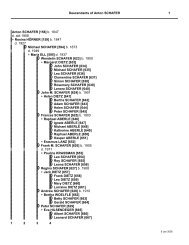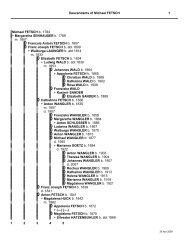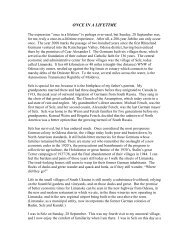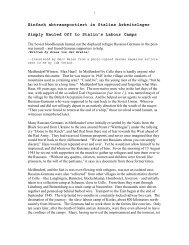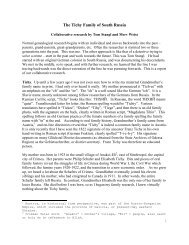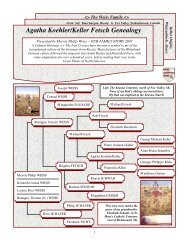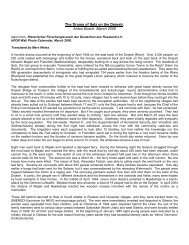JOSEPH WEISS, 1852 â 1921, my great ... - RussianRoots.ca
JOSEPH WEISS, 1852 â 1921, my great ... - RussianRoots.ca
JOSEPH WEISS, 1852 â 1921, my great ... - RussianRoots.ca
You also want an ePaper? Increase the reach of your titles
YUMPU automatically turns print PDFs into web optimized ePapers that Google loves.
<strong>JOSEPH</strong> <strong>WEISS</strong>, <strong>1852</strong> – <strong>1921</strong>, <strong>my</strong> <strong>great</strong> grandfather<br />
file://C:\Documents and Settings\Merv\My Documents\<strong>JOSEPH</strong> <strong>WEISS</strong>.htm<br />
Page 1 of 3<br />
1/29/2005<br />
<strong>JOSEPH</strong> <strong>WEISS</strong>, <strong>1852</strong> – <strong>1921</strong>, <strong>my</strong> <strong>great</strong> grandfather.<br />
Joseph was born in Selz 01 June, <strong>1852</strong>. His father Karl Joseph was 38 years old. His mother was<br />
Elizabeth Degenstein, 33. Joseph would have been born just as the work and toil of two generations of<br />
Germans in South Russia was beginning to blossom. By 1859 the population of Selz had risen to 1,573<br />
souls as the 104 founding families of 1808 had firmly taken root. Of these, 68 families had come from<br />
Alsace, and indeed the majority of all six villages in the Kutschurgan district were Alsatian Catholics.<br />
Selz was named after Seltz on the River Rhine, a small ancient town with over a thousand years of<br />
history, about 25 miles north of Strasbourg in present-day France. The village of Selz, Kherson<br />
province, Odessa district is lo<strong>ca</strong>ted about 60 versts (60 km) northwest of Odessa. The first mayor of<br />
Selz was an Alsatian farmer from Neeweiler named Michael Fetsch. Today’s Russian name for Selz is<br />
Limanskoye. Many immigrants to North Ameri<strong>ca</strong> from this area simply listed “Odessa” as their<br />
previous residence.<br />
Although living in Russia, Joseph would have grown up totally German. He would have spoken only<br />
German at home, in school, and listened to German sermons in church. He would have attended<br />
sumptious three-day“hochzeits”, and celebrated “Dreikönig”, the Feast of Epiphany on January 6, or the<br />
twelfth night of the Christmas Season. He would have celebrated his “Namenstag” or “Names Day”,<br />
Saint Joseph, the <strong>ca</strong>rpenter of Nazareth, on March 19. As a youngster he would learned to be<br />
apprehensive of the “Belzenickl” on Christmas Eve, who punished small boys and girls who did not<br />
behave at home. He would have learned to play <strong>ca</strong>rds with a variety of <strong>ca</strong>rd games, including<br />
“durakel”. He would have learned mild profanities from his father, like “A G’witter noch amol!” and<br />
“A Starndunnerwetter”. He would have eaten the same foods that I did growing up: kuchen, borscht,<br />
schmutzkiechel, Kässeknepfle, Schwartemaje, palatchinta, koladetz, and many others. Joseph lived his<br />
German culture in peace and freedom. Only as an adult, raising his growing family, did he begin to feel<br />
the effects of a Russian backlash. As he lived through the apex of German culture in South Russia, so<br />
he also lived to see the beginning of the end. Joseph died in Selz in <strong>1921</strong>, according to the EWZ record<br />
of his son-in-law, Friedrich Thomas. I don’t know the <strong>ca</strong>use of death, but <strong>1921</strong> coincides with the first<br />
large-s<strong>ca</strong>le famine which followed the October Revolution and the Russian Civil War. Joseph died in<br />
his sixty-ninth year, coincidentally the same age at which <strong>my</strong> father, Remigius, died.<br />
By 1912, Selz had become quite a sophisti<strong>ca</strong>ted town. It had grown to 2,966 people, keeping in mind<br />
that many families had already left to settle in daughter colonies and to emigrate. In 1912, there were<br />
298 yard-lots in the town. While agriculture had been the principal occupation of the villagers for most<br />
of the preceding 100 years, by 1912 almost half of the householders were engaged in some craft or<br />
trade. There was simply not enough land. The majority of the artisans were fork makers and wagon<br />
smiths, whose products were sold all over Russia. As well as being the administrative centre of the<br />
Kutschurgan district, Selz be<strong>ca</strong>me known as an important manufacturing center. From Joseph Height’s<br />
book: “There were nine flour mills, of which three were steam-driven, an iron foundry, a plumbing<br />
shop, 4 paint shops, 6 <strong>ca</strong>binet shops, 49 wood-working shops and 29 blacksmith shops…(as well as) 32<br />
stores and shops”. A number of wine taverns, whiskey stores, and even a tobacco mill attested to the<br />
prosperity of the town. During Joseph’s time, pipe-smoking was common among the men, and snuff<br />
was a <strong>great</strong> delight to the older women. In 1912, Selz had a large parochial school, a Progymnasium or<br />
Junior High School, an orphange and a 40-bed community home for the elderly, sick and poor, as well<br />
as two credit unions. Selz held a weekly “bazaar” or market where farmers sold livestock and farm<br />
produce. Twice a year the town hosted a “Jahmarkt” or country fair. Up until World War I, Selz was<br />
considered the wealthiest of the Kutschurgan towns.<br />
But rising above all these accomplishments, the Selz people were most proud of their church, “The<br />
Church of the Assumption”. A veritable basili<strong>ca</strong>, this monumental <strong>ca</strong>thedral was built in classi<strong>ca</strong>l<br />
Renaissance style with two neo-baroque towers. Constructed of quarried limestone, it was 167 feet
<strong>JOSEPH</strong> <strong>WEISS</strong>, <strong>1852</strong> – <strong>1921</strong>, <strong>my</strong> <strong>great</strong> grandfather<br />
file://C:\Documents and Settings\Merv\My Documents\<strong>JOSEPH</strong> <strong>WEISS</strong>.htm<br />
Page 2 of 3<br />
1/29/2005<br />
long, 77 feet wide, and 47 feet high. The twin towers stretched to 190 feet. Every feature inside and out<br />
reflected the best materials and workmanship. It had no equal anywhere in the diocese and was<br />
generally considered one of the finest churches in all of South Russia, (Joseph Height). My grandparents<br />
would get married in this church. It was financed entirely by the voluntary contributions of the 370<br />
families of Selz. The building committee was headed by Rochus Rissling, and driven by the<br />
indomitable spirit of Father Joseph Nold, a native of nearby Franzfeld. (Father Nold married <strong>my</strong><br />
grandparents.) Begun in 1897, the new church was consecrated by Bishop Anton Zerr on Sunday,<br />
November 25, 1901. No doubt, Joseph Weiss was present at the celebrations, having provided some of<br />
the voluntary labor and contributing his share of the 130,000 rubles cost. It is commonly said that<br />
“necessity is the mother of invention”; likewise the story of Selz gives proof to the dictum—agriculture<br />
is the mother of civilization.<br />
Sometime in the 1870’s, Joseph Weiss married Margaretha Goldade. Margaretha was born 23 March,<br />
1849 in Selz, making her 3 years older than Joseph. Margaretha’s parents were Stephan Goldade and<br />
Genoveva Thomas. Joseph’s and Margaretha’s marriage certifi<strong>ca</strong>te was not lo<strong>ca</strong>ted in Selz Church<br />
records, although both had grown up in Selz. Joseph’s older brother, Ludwig, was married in Selz in<br />
1869, as was Joseph’s older sister, Cecilia in 1871.<br />
Children of Joseph Weiss and Margaretha Goldade:<br />
1. Joseph Weiss was born 12 Jun 1874. I assume this child died young be<strong>ca</strong>use no further evidence or<br />
reference has been found.<br />
2. Anton was born 24 October 1876 and his marriage record gives his age as 22, when he married<br />
Barbara Mueller on 02 August, 1899. I have records for six children—Margaretha, Fransiska, Joseph,<br />
Caspar, Eugenia, Peter. They would be first cousins to <strong>my</strong> Dad. The 1944 village map of Selz shows a<br />
resident “Pet. Weiss”. It may be assumed that this is the same Peter.<br />
3. Elizabeth, born 11 May 1880 in Selz. Elizabeth married Johannes Schwab on 30 October, 1900 in<br />
Mannheim, another Kutschurgan village. I have the EWZ record of their daughter, Magdalene, who was<br />
married to Johannes Weisbeck. Magdalene made the trip back to Germany with five children in the<br />
summer of 1944. Another EWZ record indi<strong>ca</strong>tes that Elizabeth was married to a Ludwig Schwab, so<br />
she was possibly married a second time.<br />
4. Konrad, born 14 December, 1882. He married Brigetta Fetsch on 10 August, 1908. My<br />
grandparents, Konrad and Brigetta were born in Selz, grew up in Selz, and emigrated to Canada in<br />
April 1913. Konrad was the only Weiss from this family to come to North Ameri<strong>ca</strong>. (A retrieved birth<br />
record actually gives Conrad’s birthday as 09 December, 1882.)<br />
5. Dorothea was born 26 March 1885, and I assume she died young as I have found no further reference<br />
to her. So far, her name has not appeared in any death records.<br />
6. Genovieve was born 18 October, 1887 and named after her maternal grandmother. Genovieve<br />
married Dominik Baumstarck in August of 1910. EWZ records show their children as Margaretha born<br />
02 April, 1922, Johannes born 17 May 1924, and Elizabeth born 29 July 1927. All were born in Selz,<br />
cousins <strong>my</strong> Dad never knew.<br />
7. Margaretha was born in Selz on 21 July, 1890. Be<strong>ca</strong>use this Margaretha is not part of oral family<br />
history, I <strong>ca</strong>n assume that this girl died very young, or perhaps in child-birth be<strong>ca</strong>use we know that<br />
Joseph’s first wife, Margaretha Goldade, died and he re-married.<br />
Joseph Weiss married a second time to Fransizka Weichel in Selz on 22 November, 1893. I have<br />
conflicting records on the marriage date, but Fransizka is listed as a widow, 28 years old. On an EWZ<br />
record, her father’s name is given as Martin Weichel. I do not know the name of her first husband, but
<strong>JOSEPH</strong> <strong>WEISS</strong>, <strong>1852</strong> – <strong>1921</strong>, <strong>my</strong> <strong>great</strong> grandfather<br />
file://C:\Documents and Settings\Merv\My Documents\<strong>JOSEPH</strong> <strong>WEISS</strong>.htm<br />
Page 3 of 3<br />
1/29/2005<br />
family lore is that she brought a daughter, Regina, into the Joseph Weiss family. I have found no<br />
confirmation of this. On their EWZ records, Jakob and Brigetta agree that their mother Fransizka died<br />
in 1933, but one says she died in Selz, the other in Elsass. Elsass was another Kutschurgan village. You<br />
will note that 1933 coincides with the devastating famine years of 1932-33, as Stalin enforced his<br />
system of collectivization of agriculture. While the entire country starved, he sold every kernel of grain<br />
the country produced to obtain foreign currency to fund a growing military. In January, 2004 I received<br />
a death record – 08 Nov 1901-- for a Fransis<strong>ca</strong> Weiss, 13 years of age, with parents recorded as Joseph<br />
Weiss and Fransis<strong>ca</strong> Weigel. A thirteen year old in 1901 would have been born in 1888, and thus could<br />
not be their child. Is this perhaps the girl, Regina, Fransis<strong>ca</strong> Weigel’s daughter, about whom Conrad<br />
told his children? Or is the age incorrect, and this is really the daughter born in 1899? See below.<br />
Children of Joseph Weiss and Fransizka Weichel:<br />
1. Jakob, born 31 July, 1894. He married Margarette Liebham on 02 October, 1918, and their EWZ<br />
forms list 3 children: Agnesia, Joseph, and Jakob. The form says that Joseph is in a Hitler Youth Camp<br />
in Prussia. He would have been 17 that summer they were forced to leave Selz and trek to Poland. All<br />
boys and young men were pressed into military service. Keep in mind too, that nearly all of the<br />
Germans from Russia that survived WW II were claimed by Stalin and forcibly re-lo<strong>ca</strong>ted to Asiatic<br />
Russia after the war. Jakob’s name appears on a list titled “The Selz 1919 Military Lists” found in the<br />
Odessa Archives. His father is given as Joseph and his year of birth is listed as 1894—definitely the<br />
same Jakob, half-brother to <strong>my</strong> grandfather Konrad.<br />
2. Stephan. I only have this name from Aunt Betty’s and Uncle Frank’s notes. I have no information<br />
on Stephan.<br />
3. Fransis<strong>ca</strong>, born 21 Jan 1899. Retrieved from Saratov archives. No other information.<br />
4. Brigetta, born 01 May 1901, married Friedrich Thomas of Selz on 20 October, 1920. Brigetta and<br />
their 21-year old son, Nikolaus, are listed on Friedrich’s EWZ form.<br />
Except for Konrad, I do not know the ultimate fate of any of Joseph’s children. From EWZ records, I do<br />
know that Elizabeth, Genovieve, Jakob and Brigetta survived the turbulence of post-revolution Russia<br />
and the two <strong>great</strong> famines, be<strong>ca</strong>use they were registered in 1944 in the holding <strong>ca</strong>mps in Poland. In the<br />
fall of 2004, I established contact with Jakob Weiss, son of Jakob, and Luise Weiss, widow of Joseph<br />
Weiss, son of Jakob.



